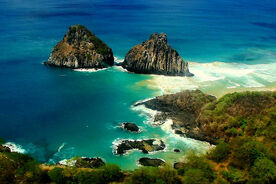
Bawám is a city-state east of the southern tip of the central main continent, along the coast. It was originally a trading post along the Spice Route between Chalmean and Tll-Ikish lands, and eventually grew into a prosperous port because of it's strategic location, calm waters and rich marine life, which supports a population of roughly 10.000 individuals. Those who inhabit the city of Bawám are called Biwám.
Demography and Ethnic Composition.
Bawám's population of around 100.000, of which around half live within the city walls, is made up mostly of people of mixed Chalmean and Tll heritage, with around 15% pure or mostly pure Tll-Ikish and less than 3% Chalmeans. The reason for such a small population of non-mestizos is multiple: First, hibridation occurrs not only on the city itself, but due to trade between the regions a growing mestizo population exists in northern Chalmea, and mestizos don't enjoy the social status of full natives, so they tend to migrate into Bawám. Further, migration from Chalmean territory into the port of Bawám has historically been individual, so families rarely move as a whole. Instead, individuals migrate on their own, frequently by joining trade caravans along the Spice Route. Also, there is a certain degree of exophilia in male Chalmean culture, which is to say that the female Tll-Ikish biotype [hairless, slitted eyes and high cheekbones] is coherent with commonplace chalmean images of female beauty, which revolve around short stature, dark skin and small eyes. The small eyes in particular evoke the image of half-closed eyes in the Chalmean male mind, which is generally associated with sexual arousal. The same happens with the reddish skin, which suggests, again to the male Chalmean mind, health, vitality, and sexual arousal. In a way, this effect is similar to the use of belladona by europpean women to promote pupil dilation, which in turn suggest to males, at a subconcious level, sexual arousal in the female. For their part, the Tll-Ikish females were mostly the wives and relatives of merchants, who came and intermarried with the Chalmeans. Tll-Ikish women are attracted to the Chalmean's height and broad, squarish chin and shoulders, viewing them as very masculine (though miscegenation is kinda taboo among the Tll-Ikish, so intermarriage was limited to the mercantile and artisanal classes)
For around 100 years the city has enjoyed a favourable economic climate, being almost a forced stop along the spice route, and has grown in population accordingly. The fertility rate of the past 60 years averages at 6,6 live births per woman, and due to improved sanitary conditions during the same period, child mortality has been quite low for their technological level, a little over 45%. Overall, migration and death considered, the population of Bawám has grown at around a 2,6% every year since the founding of the city itself, 60 years ago. Before that, Bawám was a small-time Drs-Ikish fishing village.
Culture
Bawám is neither Tll nor Chalmean in cultural terms. It's culture is more of a coarse patchwork canvas than a coherent tapestry, and this rich diversity manifests itself when walking its streets. There are ethnic barrios where immigrants from different parts of Namjog , Keskus and the Isle come together, most of the time together but not scrambled, although the central and port districts are dominantly mestizo. This diversity fosters a culture of mutual tolerance, which in turn opens opportunities for immigrants of various backgrounds, making Bawám perhaps the most cosmopolitan city of the neolithic period.
Society
Economy
Bawám is a coastal and river port and an important stop along the spice route. While it has thriving fishing and agricultural sectors, and its artisan class certainly benefits from the exchange of ideas and techniques from two cultures that have come in contact only recently, it's main economic activity is trade itself, followed closely by services.